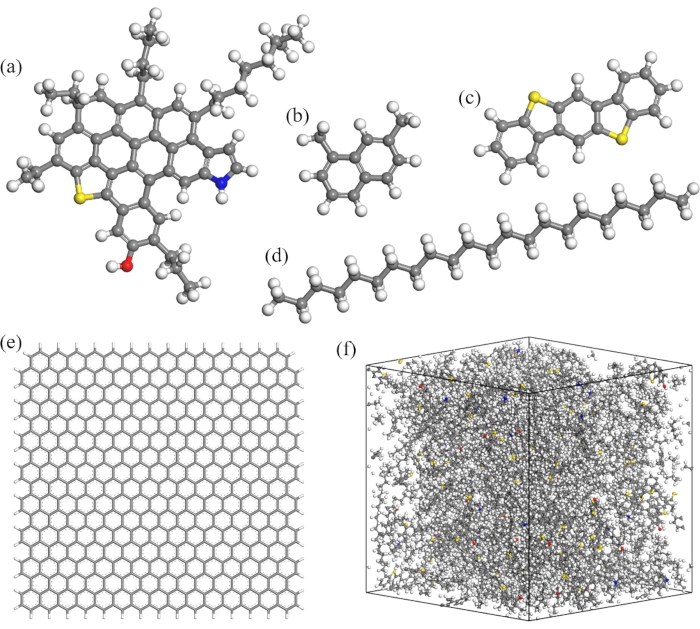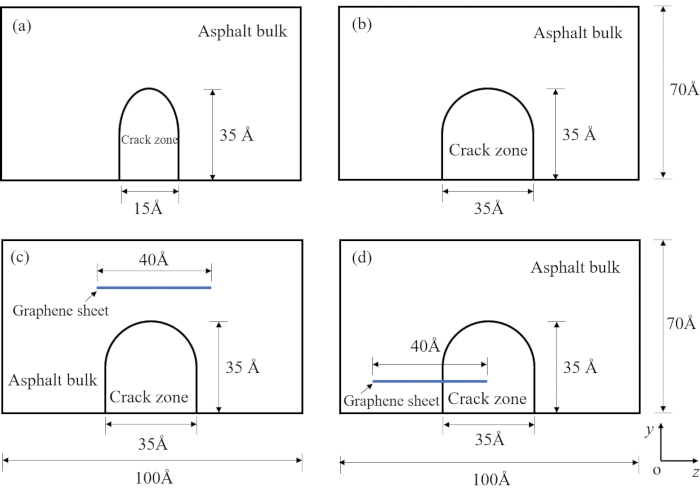石墨烯结构增强的先进自愈合沥青:原子学见解
Summary
与纯沥青相比,石墨烯改性沥青纳米复合材料显示出先进的自愈能力。在该协议中,为了了解石墨烯在自愈过程中的作用,并从原子水平上探索沥青组分的自愈机制,应用了分子动力学模拟。
Abstract
石墨烯可以提高沥青的自愈性能,具有高耐久性。然而,现阶段石墨烯改性沥青纳米复合材料的自愈行为和掺入石墨烯的作用尚不清楚。本研究通过分子动力学模拟研究了纯沥青和石墨烯改性沥青的自愈性能。介绍了石墨烯具有两种裂纹宽度和位置的沥青块体,并分析了沥青组分与石墨烯片之间的分子相互作用。结果表明,石墨烯的位置对沥青的自愈行为有显著影响。裂纹表面附近的石墨烯通过π π堆叠与芳香族分子相互作用,可以大大加速自愈合过程,而裂纹尖端顶部区域的石墨烯对工艺的影响很小。沥青的自愈合过程经历了沥青质,极性芳香族和萘芳香族分子的重新定向,以及裂纹表面之间饱和分子的桥接。这种对自愈机制的深入了解有助于了解增强自愈性能的知识,这将有助于开发耐用的沥青路面。
Introduction
在日常车辆负载和各种环境条件下的劣化,以及沥青在使用过程中的老化会导致退化甚至结构故障,即开裂和凹槽,这会进一步削弱沥青路面的耐用性。沥青修复微裂纹和空隙的固有响应自动帮助它从损坏中恢复并恢复强度1。这种自愈能力可以大大延长沥青的使用寿命,节省维护成本,并减少温室气体的排放2,3。沥青的自愈行为通常取决于几个影响因素,包括其化学成分,损伤程度和环境条件4。需要提高沥青的自愈能力,可以在短时间内完全愈合损伤;这引起了人们对土木工程中沥青路面更好的机械性能和耐久性的广泛研究兴趣。
提高沥青自愈能力的新方法主要包括三种方法-诱导加热,封装愈合和掺入纳米材料-可以单独或同时应用5,6.诱导加热可以显着提高沥青的流动性,并激活其自愈性以进行恢复7.沥青通过诱导加热的自愈技术可以归因于辅助自愈技术,这表明沥青的自愈性能通过外部刺激得到改善。添加钢丝绒纤维的目的是增强导电性,从而提高沥青粘结剂的愈合能力8.诱导热量的方法是将这些导电纤维暴露在高频交变电磁场中,这可以诱导涡流,热能可以通过导电纤维扩散到沥青粘结剂中。9.钢丝绒纤维不仅能提高导电性,还能增强导热性,两者都能对沥青的自愈性能产生积极影响。然而,为纤维选择适当的混合时间具有挑战性10.纤维的长度随着混合时间的增加而减少并影响导热性,而混合时间的减少导致纤维簇并阻碍沥青的机械性能9.包封方法可以提供陈年沥青的轻质成分,如芳烃和饱和剂,并刷新沥青的自愈合能力11,12.但是,这是一次只治疗一次,释放后无法补充愈合材料。随着纳米技术的发展,纳米材料已成为增强沥青基材料的有前途的改性剂。与纳米材料结合的沥青粘结剂具有更好的导热性和机械性能13.具有优良机械性能和高热性能的石墨烯被认为是提高沥青自愈能力的极好候选者14,15,16,17.石墨烯改性沥青的愈合性能增加可归因于石墨烯增加了沥青粘结剂的加热能力并在沥青粘结剂内部产生传热,这意味着石墨烯改性沥青可以更快地加热并达到比纯沥青更高的温度18.产生的热量可以以比通过纯沥青更快的速度传递到整个石墨烯改性沥青中。沥青粘结剂的裂纹区域可以很容易地被具有更高温度和更高加热能力的热流影响并更快地愈合。如果沥青裂缝表面存在等于或大于愈合活化能的能量,则自愈合反应将开始19.石墨烯可提高热活化愈合性能,加快沥青愈合速度19,20.此外,石墨烯在愈合过程中可节省高达50%的加热能量,这可以提高能源效率并降低维护成本21.作为微波吸收材料,据报道石墨烯在微波加热的休息期间可以提高沥青的愈合能力。22.预计在沥青中添加石墨烯不仅会提高机械性能,还会提高自愈和节能能力,这需要深入了解自愈机理。
纳米级的自愈合主要是由于沥青分子在裂面23处的润湿和扩散。由于沥青由各种极性和非极性分子组成,其自愈能力与不同组分的沥青分子的分子相互作用和运动密切相关1.然而,目前的研究主要依靠实验技术来量化宏观力学性能,这导致在试图了解愈合机理时微观结构变化和沥青分子之间相互作用的信息缺失。石墨烯在沥青自愈能力中的增强机理现阶段也不清楚。分子动力学(MD)模拟在研究纳米复合材料系统的分子相互作用和运动中发挥着重要作用,并将微观结构变形与分子相互作用和运动联系起来24,25,26,27,28,29,30,31.MD模拟在分析实验32,33无法轻易访问的材料行为方面变得越来越流行。现有的研究表明,MD模拟在沥青系统中是可行性和可用性的。沥青和沥青复合材料的内聚力,附着力,时效和热机械性能可以通过MD模拟34,35,36,37进行探索。沥青的自愈行为也可以通过MD模拟38,39,40预测。因此,人们认为使用MD模拟进行研究是了解自愈和强化机制的有效方法。
本研究的目的是通过MD模拟,研究纯沥青和石墨烯改性沥青纳米复合材料的自愈行为,并了解石墨烯在提高沥青愈合能力中的作用。纯沥青和石墨烯改性沥青复合材料的自愈合模拟是通过在初始结构中引入裂缝进行的。自愈能力的特征在于原子数的轮廓,断裂面处分子的重新定向和纠缠,以及沥青组分在自愈合过程中的迁移率。通过研究石墨烯在不同部位的愈合效率,揭示了石墨烯对沥青自愈能力的增强机理,有助于以最佳方式监测纳米填料,从而延长沥青路面的使用寿命。对原子尺度的自愈能力的研究可以为未来的研究开发先进的沥青基材料提供一种有效的方法。
根据沥青化学,沥青由不同极性和形状的各类烃类和非烃类组成,主要可分为沥青质、极性芳烃、环烷芳烃和饱和41、42四种组分。沥青质分子比沥青中的其他分子相对更大,更重,平均原子质量约为750 g / mol,分子直径在10-20 Å范围内。人们普遍认为,沥青质由含有杂原子的大芳核组成,并被不同长度的烷基43包围。构建改性沥青质分子,如图1a所示。极性芳烃和环烷芳烃的分子是根据沥青分子的极性和元素比构建的,其中苯并二苯并噻吩(C18H10S2)代表极性芳族分子,1,7-二甲基萘(C12H12)被选为代表萘芳族分子,如图1b-c所示。N-二十二烷(n-C 22H46)的构造如图1d所示。选择表1中列出的沥青分子参数,并用于满足实验41中实际沥青的元素质量分数,原子比和芳香族/脂肪族比。在我们之前的研究中已经定义了相同的质量比,其他热机械性能如密度,玻璃化转变温度和粘度与实际沥青36的实验数据非常吻合。本研究中应用的石墨烯的分子结构如图1e所示。本研究采用的石墨烯片与实际情况相比没有缺陷,也没有褶皱,而真正的石墨烯片通常存在原子空位和Stone-Wales缺陷44等几个缺陷,部分石墨烯片材在沥青基体45的混合过程中可以折叠。这些不完美的情况在这项研究中没有考虑,因为我们专注于石墨烯片的位点对自愈性能的影响,并选择它作为唯一的变量。石墨烯片材在缺陷和折叠情况方面的变量将是我们未来研究的重点。本研究中石墨烯与沥青的质量比为4.75%,这是实验中石墨烯改性沥青的正常情况(<5%)46,47。

图1:化学结构。(a)沥青质分子(C53H55NOS),(b)环烷芳香族分子(C12 H 12),(c)极性芳香分子(C 18H10S2),(d)饱和分子(C22H46),(e)石墨烯和(f)纯沥青的原子模型。对于原子沥青模型,碳、氧、氮、硫和氢原子分别以灰色、红色、蓝色、黄色和白色显示。请点击此处查看此图的大图。
| 沥青模型 | 质量(克/摩尔) | 化学式 | 分子数量 | 总质量(克/摩尔) | 质量分数(%) |
| 沥青 | 754.04 | C53H55无 | 43 | 32423.72 | 26 |
| 萘芳香族 | 156.22 | C12H12 | 65 | 10154.3 | 8 |
| 极性芳香族 | 290.38 | C18H10S2 | 74 | 21485.16 | 17 |
| 饱和 | 310.59 | C22H46 | 205 | 63670.95 | 49 |
| 沥青粘结剂 | 387 | 127734.13 | 100 | ||
| 石墨烯 | 6369.28 | C525H63 | 1 | 6369.28 |
表1:纯沥青模型和石墨烯改性沥青模型的整体组分。
关于下面描述的协议,将两种不同尺寸的楔形裂纹插入沥青模型的中间,具有钝裂纹尖端和两个平行的裂纹表面,而沥青块体的中间顶部区域保持不变。选择两种裂纹宽度为15 Å和35 Å,如图2a-b所示。选择15 Å的原因是裂纹宽度应比12 Å的截止值宽,以避免沥青分子在平衡过程中的早期自愈,同时研究小裂纹的极端情况。选择35 Å的原因是裂纹宽度应大于34 Å的饱和分子长度,以防止桥接效应。裂缝的高度为35 Å,与盒子宽度相同,裂缝的深度为70 Å,与盒子长度相同。在实际情况下,观察到的微裂纹尺寸可以在几微米到几毫米的范围内变化,这远远大于我们在这里建模的长度尺度。通常,MD仿真中的长度尺度仅限于100 nm的尺度,这仍然比实际裂纹尺寸小几个数量级。然而,裂纹在纳米尺度上开始并生长成具有连续变形的宏观裂纹48。了解纳米尺度的自愈合机制有助于防止裂纹在宏观尺度上的生长和进一步传播。尽管所选的裂纹尺寸在纳米范围内,但其结果仍然具有影响力,适用于探索沥青分子的自愈行为。石墨烯片在裂纹区域有两个位置:一个在裂纹尖端的顶部,另一个垂直于左裂纹表面。已经发现,这些是石墨烯改性纳米复合材料中石墨烯最常见的位置,具有裂纹49。

图2:纯沥青和石墨烯改性沥青的自愈方案。 裂缝宽度为(a)15 Å和(b)35 Å的纯沥青的自愈合模型。石墨烯改性沥青与石墨烯片的自愈合模型位于(c)裂纹尖端的顶部和(d)垂直于裂纹表面。 请点击此处查看此图的大图。
在MD仿真中,沥青纳米复合材料中的分子内和分子间相互作用由一致价力场(CVFF)50描述,该力场与沥青和石墨烯基材料配合良好。CVFF的功能形式表示为以下表达式:
 1
1
这里,总能量 E总 由键合能项和非键合能项组成。键合相互作用包括共价键拉伸、键角弯曲能、扭转角旋转和前四项中表示的不当能。非键合能包括用于范德华(vdW)项的LJ-12-6函数和用于静电相互作用的库仑函数。CVFF已被广泛用于模拟51,52沥青材料。模拟的物理和力学性能,如密度、粘度和体积模量,与实验数据吻合良好,证明了CVFF51的可靠性。CVFF不仅适用于无机材料,而且还已成功应用于由有机相和无机相组成的结构中,例如沥青 – 二氧化硅52 和环氧 – 石墨烯53的体系。此外,石墨烯和沥青之间的界面相互作用可以用CVFF36,54来表征。由于选择力场的主要部分是确定沥青 – 石墨烯界面,因此CVFF描述的非键合相互作用更可靠,这也在我们之前的研究36中进行了考虑。总体而言,本研究采用了力场CVFF。不同种类原子的部分电荷通过力场分配方法计算。
Protocol
Representative Results
Discussion
协议部分中的关键步骤如下:步骤1.4 – 构建和包装四种类型的沥青分子;步骤1.5 – 用裂缝建造沥青结构;步骤2.3 – 达到平衡;步骤2.4 – 执行自我修复过程。这些步骤指示协议中最有凝聚力和最重要的内容。为了创建插入裂缝的所需形状,与Material Studio中的普通包装相比,包装过程进行了修改。在模拟盒内创建并填充裂缝形状,然后将沥青分子填充到模拟盒的另一部分。之后,在创建的裂缝轮廓周围删?…
Offenlegungen
The authors have nothing to disclose.
Acknowledgements
作者感谢香港城市大学战略研究资助计划第7005547号的支持,以及中国香港特别行政区研究资助局(研资局)的支持,项目编号为1。R5007-18,并得到深圳市科技创新委员会的资助,JCYJ20170818103206501。
Materials
| Atomistic models of asphalt and graphene/Materials Studio | BIOVIA | Materials Studio 8.0 | The atomistic models are built for molecular dynamics simulations. |
| Large-scale Atomic/Molecular Massively Parallel Simulator Package | Sandia National Laboratories | lammps-stable20 | The equilibrium is achieved under NPT ensemble, and the atomistic models get self-healed. |
| OVITO | Materials Science Department of Technische Universität Darmstadt, Germany | ovito-basic-3.1.0-win64 | The self-healing behaviors of the atomistic models are visualized. |
| Origin | OriginLab | Origin 2018 64Bit | The contours of the atom numbers of the trajectory are drawn and analyzed. |
Referenzen
- Sun, D., et al. A comprehensive review on self-healing of asphalt materials: Mechanism, model, characterization and enhancement. Advances in Colloid and Interface Science. 256, 65-93 (2018).
- Hung, A. M., Mousavi, M., Fini, E. H. Implication of wax on hindering self-healing processes in bitumen. Applied Surface Science. 523, 146449 (2020).
- Lv, Q., et al. Investigating the asphalt binder/mastic bonding healing behavior using bitumen bonding strength test and X-ray Computed Tomography scan. Construction and Building Materials. 257, 119504 (2020).
- Liang, B., et al. Review on the self-healing of asphalt materials: Mechanism, affecting factors, assessments and improvements. Construction and Building Materials. 266, 120453 (2021).
- Xu, S., et al. Self-healing asphalt review: From idea to practice. Advanced Materials Interfaces. 5, 1800536 (2018).
- Tabaković, A., Schlangen, E. . Self-healing Materials, Advances in Polymer Science. , 285-306 (2015).
- García, &. #. 1. 9. 3. ;. Self-healing of open cracks in asphalt mastic. Fuel. 93, 264-272 (2012).
- Karimi, M. M., Amani, S., Jahanbakhsh, H., Jahangiri, B., Alavi, A. H. Induced heating-healing of conductive asphalt concrete as a sustainable repairing technique: A review. Cleaner Engineering and Technology. 4, (2021).
- Gulisano, F., Gallego, J. Microwave heating of asphalt paving materials: Principles, current status and next steps. Construction and Building Materials. 278, 121993 (2021).
- García, &. #. 1. 9. 3. ;., Schlangen, E., Ven, M. v. d., Bochove, G. v. Optimization of composition and mixing process of a self-healing porous asphalt. Construction and Building Materials. 30, 59-65 (2012).
- Aguirre, M. A., Hassan, M. M., Shirzad, S., Daly, W. H., Mohammad, L. N. Micro-encapsulation of asphalt rejuvenators using melamine-formaldehyde. Construction and Building Materials. 114, 29-39 (2016).
- Su, J. -. F., Qiu, J., Schlangen, E., Wang, Y. -. Y. Experimental investigation of self-healing behavior of bitumen/microcapsule composites by a modified beam on elastic foundation method. Materials and Structures. 48 (12), 4067-4076 (2014).
- Yoo, D. Y., Kim, S., Kim, M. J., Kim, D., Shin, H. O. Self-healing capability of asphalt concrete with carbon-based materials. Journal of Materials Research and Technology-Jmr&T. 8 (1), 827-839 (2019).
- Qin, Z., Jung, G. S., Kang, M. J., Min Jeong, M. J. The mechanics and design of a lightweight three-dimensional graphene assembly. Science Advances. 3 (1), 1601536 (2017).
- Jung, G. S., Yeo, J., Tian, Z., Qin, Z., Buehler, M. J. Unusually low and density-insensitive thermal conductivity of three-dimensional gyroid graphene. Nanoscale. 9 (36), 13477-13484 (2017).
- Campbell, P. G., Worsley, M. A., Hiszpanski, A. M., Baumann, T. F., Biener, J. Synthesis and functionalization of 3D nano-graphene materials: Graphene aerogels and graphene macro assemblies. Journal of Visualized Experiments: JoVE. (105), e53235 (2015).
- Li, H., et al. Induction heating and healing behaviors of asphalt concretes doped with different conductive additives. Advances in Materials Science and Engineering. 2019, 1-10 (2019).
- Moreno-Navarro, F., Sol-Sánchez, M., Gámiz, F., Rubio-Gámez, M. C. Mechanical and thermal properties of graphene modified asphalt binders. Construction and Building Materials. 180, 265-274 (2018).
- Liu, J., Hao, P., Dou, Z., Wang, J., Ma, L. Rheological, healing and microstructural properties of unmodified and crumb rubber modified asphalt incorporated with graphene/carbon black composite. Construction and Building Materials. 305, 124512 (2021).
- Wang, R., Qi, Z., Li, R., Yue, J. Investigation of the effect of aging on the thermodynamic parameters and the intrinsic healing capability of graphene oxide modified asphalt binders. Construction and Building Materials. 230, 116984 (2020).
- Gulisano, F., Crucho, J., Gallego, J., Picado-Santos, L. Microwave healing performance of asphalt mixture containing Electric Arc Furnace (EAF) slag and Graphene Nanoplatelets (GNPs). Applied Sciences. 10 (4), 1428 (2020).
- Li, C., Wu, S., Chen, Z., Tao, G., Xiao, Y. Improved microwave heating and healing properties of bitumen by using nanometer microwave-absorbers. Construction and Building Materials. 189, 757-767 (2018).
- Varma, R., Balieu, R., Kringos, N. A state-of-the-art review on self-healing in asphalt materials: Mechanical testing and analysis approaches. Construction and Building Materials. 310, 125197 (2021).
- Lau, D., Jian, W., Yu, Z., Hui, D. Nano-engineering of construction materials using molecular dynamics simulations: Prospects and challenges. Composites Part B: Engineering. 143, 282-291 (2018).
- Jian, W., Lau, D. Creep performance of CNT-based nanocomposites: A parametric study. Carbon. 153, 745-756 (2019).
- Wang, X. Q., Jian, W., Buyukozturk, O., Leung, C. K. Y., Lau, D. Degradation of epoxy/glass interface in hygrothermal environment: An atomistic investigation. Composites Part B: Engineering. 206, 108534 (2021).
- Jian, W., Lau, D. Understanding the effect of functionalization in CNT-epoxy nanocomposite from molecular level. Composites Science and Technology. 191, 108076 (2020).
- Hao, H., Tam, L. -. h., Lu, Y., Lau, D. An atomistic study on the mechanical behavior of bamboo cell wall constituents. Composites Part B: Engineering. 151, 222-231 (2018).
- Qin, R., Zhou, A., Yu, Z., Wang, Q., Lau, D. Role of carbon nanotube in reinforcing cementitious materials: An experimental and coarse-grained molecular dynamics study. Cement and Concrete Research. 147, 106517 (2021).
- Jian, W., Wang, X., Lu, H., Lau, D. Molecular dynamics simulations of thermodynamics and shape memory effect in CNT-epoxy nanocomposites. Composites Science and Technology. 211, 108849 (2021).
- Jing, C., et al. Regenerated and rotation-induced cellulose-wrapped oriented CNT fibers for wearable multifunctional sensors. Nanoscale. 12 (30), 16305-16314 (2020).
- Yazdandoost, F., Mirzaeifar, R., Qin, Z., Buehler, M. J. Multiscale mechanics of the lateral pressure effect on enhancing the load transfer between polymer coated CNTs. Nanoscale. 9 (17), 5565-5576 (2017).
- Doblack, B. N., Allis, T., Davila, L. P. Novel 3D/VR interactive environment for MD simulations, visualization and analysis. Journal of Visualized Experiments: JoVE. (94), (2014).
- Xu, M., et al. Improved chemical system for molecular simulations of asphalt. Energy & Fuels. 33 (4), 3187-3198 (2019).
- Xu, G., Wang, H. Molecular dynamics study of oxidative aging effect on asphalt binder properties. Fuel. 188, 1-10 (2017).
- Nie, F., Jian, W., Lau, D. An atomistic study on the thermomechanical properties of graphene and functionalized graphene sheets modified asphalt. Carbon. 182, 615-627 (2021).
- Cui, B., Gu, X., Hu, D., Dong, Q. A multiphysics evaluation of the rejuvenator effects on aged asphalt using molecular dynamics simulations. Journal of Cleaner Production. 259, (2020).
- Sun, W., Wang, H. Self-healing of asphalt binder with cohesive failure: Insights from molecular dynamics simulation. Construction and Building Materials. 262, 120538 (2020).
- He, L., et al. Self-healing behavior of asphalt system based on molecular dynamics simulation. Construction and Building Materials. 254, 119225 (2020).
- Sun, D., Lin, T., Zhu, X., Tian, Y., Liu, F. Indices for self-healing performance assessments based on molecular dynamics simulation of asphalt binders. Computational Materials Science. 114, 86-93 (2016).
- Li, D. D., Greenfield, M. L. Chemical compositions of improved model asphalt systems for molecular simulations. Fuel. 115, 347-356 (2014).
- Redelius, P., Soenen, H. Relation between bitumen chemistry and performance. Fuel. 140, 34-43 (2015).
- Schulze, M., Lechner, M. P., Stryker, J. M., Tykwinski, R. R. Aggregation of asphaltene model compounds using a porphyrin tethered to a carboxylic acid. Organic & Biomolecular Chemistry. 13 (25), 6984-6991 (2015).
- Robertson, A. W., Warner, J. H. Atomic resolution imaging of graphene by transmission electron microscopy. Nanoscale. 5 (10), 4079-4093 (2013).
- Yang, L., Zhou, D., Kang, Y. Rheological properties of graphene modified asphalt binders. Nanomaterials (Basel). 10 (11), 2197 (2020).
- Zeng, W. B., Wu, S. P., Pang, L., Sun, Y. H., Chen, Z. W. The utilization of graphene oxide in traditional construction materials: Asphalt. Materials. 10 (1), 48 (2017).
- Li, R., Xiao, F., Amirkhanian, S., You, Z., Huang, J. Developments of nano materials and technologies on asphalt materials – A review. Construction and Building Materials. 143, 633-648 (2017).
- Yu, T., Zhang, H., Wang, Y. Multi-gradient analysis of temperature self-healing of asphalt nano-cracks based on molecular simulation. Construction and Building Materials. 250, 118859 (2020).
- Gao, C., Liu, T., Shuai, C., Peng, S. Enhancement mechanisms of graphene in nano-58S bioactive glass scaffold: mechanical and biological performance. Scientific Reports. 4, 4712 (2014).
- Maple, J. R., Dinur, U., Hagler, A. T. Derivation of force fields for molecular mechanics and dynamics from ab initio energy surfaces. Proceedings of the National Academy of Sciences of the United States of America. 85 (15), 5350-5354 (1988).
- Xu, M., Yi, J., Feng, D., Huang, Y. Diffusion characteristics of asphalt rejuvenators based on molecular dynamics simulation. International Journal of Pavement Engineering. 20 (5), 615-627 (2019).
- Wang, H., Lin, E., Xu, G. Molecular dynamics simulation of asphalt-aggregate interface adhesion strength with moisture effect. International Journal of Pavement Engineering. 18 (5), 414-423 (2017).
- Yu, J., et al. Insights on the capillary transport mechanism in the sustainable cement hydrate impregnated with graphene oxide and epoxy composite. Composites Part B: Engineering. 173, (2019).
- Zhou, X., et al. Evaluation of thermo-mechanical properties of graphene/carbon-nanotubes modified asphalt with molecular simulation. Molecular Simulation. 43 (4), 312-319 (2017).
- Plimpton, S. Fast parallel algorithms for short-range molecular-dynamics. Journal of Computational Physics. 117 (1), 1-19 (1995).
- Stukowski, A. Visualization and analysis of atomistic simulation data with OVITO-the Open Visualization Tool. Modelling and Simulation in Materials Science and Engineering. 18 (1), 015012 (2010).
- Chen, Z., Pei, J., Li, R., Xiao, F. Performance characteristics of asphalt materials based on molecular dynamics simulation-A review. Construction and Building Materials. 189, 695-710 (2018).
- Sun, D., Sun, G., Zhu, X., Ye, F., Xu, J. Intrinsic temperature sensitive self-healing character of asphalt binders based on molecular dynamics simulations. Fuel. 211, 609-620 (2018).

